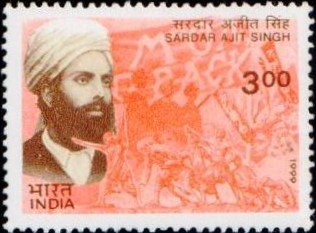
Ghadar Movement
A commemorative postage stamp on the Centenary of the Gadar Conspiracy, a plan to initiate a pan-Indian mutiny in British Indian Army and to end British Raj in India :

Issued by India
Issued on Jan 8, 2013
Issued for : Department of Posts is happy to issue a Commemorative Postage Stamp on the Ghadar Movement Centenary.
Credits :
Stamp/FDC/Brochure/Cancellation : Alka Sharma
Type : Stamp, Mint Condition
Colour : Multi colour
Denomination : 500 Paise
Stamps Printed : 0.41 Million (0.1 million for the proponent)
Printing Process : Wet Offset
Printer : India Security Press, Nashik
About :
- The Ghadar Movement constitutes an important milestone in the history of India’s struggle for freedom. The word Ghadar means mutiny. The movement aimed at bringing about a revolution in India in order to secure liberation from the British rule. Organised in USA (Astoria, Oregon) in the year 1913, the headquarter of the Ghadar Party was established in San Francisco.
- The birth of such a movement in America was a result of an exceptional coming together of a number of Indian revolutionaries in exile and a large number of migrant Punjabi Sikh farmers and workers. The contact with the outside world and exposure to new ideas opened their minds. They started understanding the meaning of freedom and reasons of the poverty and exploitation under colonial domination. They dreamt of complete independence of India and worked towards instilling patriotic feelings in young Indians and train them for a rising in India. A distinguishing feature of this movement was its inclusive character; it shed parochialism and transcended the boundaries of caste, religion and region.
- The name of the movement came from the weekly newspaper named Ghadar which was published first in Urdu then in English, Hindi, Gujrati, Gurmukhi and Pushtu and circulated free of charge among Indians settled in different parts of the world. The declaration made by the paper Ghadar in its first issue of November 1, 1913, was categorical and audacious: “Today there begins in foreign lands, but in the language of the country, a war against the English rule in India”. The founding editor of this paper was the reputed intellectual and revolutionary, Lala Hardayal. With Sohan Singh Bhakna as the President, Hardayal was also the first secretary of the Ghadar Party. Other prominent leaders of the Ghadar Party were Taraknath Das, Mohammed Barkatullah, Rash Bihari Bose and Vishnu Ganesh Pingley.
- The objective of preparing for the freedom of India crystallised during a series of Hardayal’s meetings and discussions with leading members of the Punjabi community like Jwala Singh, Bhakna, Kanshi Ram, Sarabha, Gobind Behari Lal and others in California and around Portland and Astoria. The group felt that those who were not free in their own countries could not hope for respect in foreign lands. The group felt that Liberation from British rule was possible only through an armed struggle.
- The Canadian government’s cruel treatment of the Indian passengers of steamship Komagata Maru and the sudden eruption of the war between Germany and England upset their plans. When, after two months long legal battle and appeals to British authorities, the 376 passengers were not allowed to land in Canada and the ship was forced to return to Calcutta in India, the Indian community in North America was livid with rage. Ghadar Party planned a Pan-Indian mutiny in the British Indian Army, from Punjab to Singapore, in February 1915 to overthrow the British Raj in the Indian subcontinent. The mutiny was ultimately thwarted as the British Indian intelligence successfully infiltrated the Ghadar movement. Despite the fact that Ghadar movement could not achieve its objective of freedom from British Raj, the impact of Ghadar movement was phenomenal.
- The Ghadar Memorial, now under the charge of the Consul-General of India at San Francisco, continues to remind Indians of the valiant efforts of the Ghadarites.
- Text : Based on the material provided by the proponent.








[…] Har Dayal, a well known revolutionary nationalist, founder of the Ghadar Movement and a thinker and scholar, was born on 14th October, 1884 in Delhi. His father Shri Gauri Dayal […]
[…] to Afghanistan while Maulana went to Hijaz. Obaidullah Sindhi established contact with the Ghadar Party leaders and when the Provisional Government of Azad Hind was proclaimed in Kabul, he became […]
[…] and had a brief life. While in the United States, he worked in cooperation with the Hindusthan Ghadar Party. He was sent as their emissary to Tibet to organise a revolt against the British. In his […]